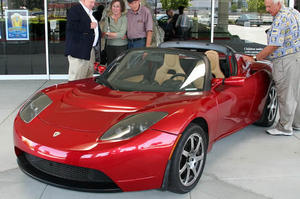Electrical carsFuture electric vehicle to run unlimited distances
Electrically powered vehicles (EV) are promising environmentally friendly alternatives for combustion engine-based automobiles; batteries used in present-day EV, however, limit the continuous running distance from one charge; researchers propose a potentially revolutionary solution for powering EVs capable of running unlimited distances

The Teswla modils are more efficient than most others // Source: metaefficient.com
Electrically powered vehicles (EV) are promising environmentally friendly alternatives for combustion engine-based automobiles. Electric motors offer significant advantages including high energy efficiency; low noise emission; low temperature operation; no emission of exhaust gases; and the possibility of power regeneration from kinetic motion when a vehicle slows down.
Batteries used in present-day EV, however, limit the continuous running distance from one charge. Furthermore, it takes an impractical long time to recharge the batteries, and loading larger batteries increases the onboard load, which leads to greater consumption of energy to move vehicles. Notably, batteries are too expensive for use in replacing all existing cars, buses, and trucks.
A Toyohashi University of Technology release reports that Masahiro Hanazawa at Toyota Central R&D Labs. and Takashi Ohira at Toyohashi University of Technology (Toyohashi Tech) propose a potentially revolutionary solution for powering EVs capable of running unlimited distances. The basic concept stems from electric railways, where each car of the train is power from an overhead wire while the car runs on tracks. The researchers imagined how an automobile running along a road could do so without resorting to dangerous contacting devices such as pantographs, and finally came up with a profound and novel idea: The source of energy from power lines is up-converted into radio frequency (RF) by high-speed inverters implanted along tracks in the road. The RF voltage is applied to a balanced metal track embedded under the surface of the road. The EV picks up the RF voltage via electrical capacitance between the metal and a steel belt installed inside of the tires of the EV.
The researchers conducted feasibility experiments to test their ideas, and to explore the RF frequencies where such power transfer is effective and practical. In the experiments, the researchers put small metal plates on the floor and inside a tire, and positioned another metal plate above the tire. Finally, they measured the electrical impedance between the two plates. This set-up should be equivalent to double the impedance between a plate and a steel belt.
Experimental results showed the impedance to depend linearly on the RF frequency, and to exhibit 2000-j700 ohm at 1 MHz. Then the researchers designed and implemented a 50 ohm reactance circuit to match this, where 50 ohm is the standard impedance for RF transmission lines. This experimental set-up enabled a high transmission efficiency with sub 1 dB loss.
The release notes that although these were low power experiments, they demonstrate the feasibility of energy transfer from the road to a running automobile. If this energy transfer could be increased to tens of kW on express ways, then in the future it may be possible to take EV from your house to the nearest interchange with a small battery and then cruise on the expressway via this feeder system as far as you want without concern about battery discharge problems.
— Read more in Masahiro Hanazawa and Takashi Ohira, “Power Transfer for a Running Automobile,” IEEE MTT-S International Microwave Workshop Series on Innovative Wireless Power Transmission, IMWS-IWPT2011 (May 2011): 77-80
